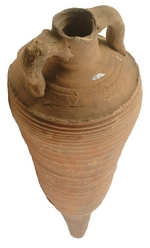Roman Amphorae: a digital resource
University of Southampton, 2005. (updated 2014) https://doi.org/10.5284/1028192. How to cite using this DOI
Data copyright © University of Southampton unless otherwise stated
This work is licensed under the ADS Terms of Use and Access.
Primary contact
Dr
David
Williams
Dept of Archaeology
University of Southampton
Avenue Campus
Highfield
Southampton
SO17 1BJ
England
Tel: 080 593032
Resource identifiers
- ADS Collection: 463
- DOI:https://doi.org/10.5284/1028192
- How to cite using this DOI
Late Roman Amphora 7

Courtesy of Museum of London
David Williams
Distinctive FeaturesThis type has a tubular neck with a simple beaded rim, a sloping or carinated shoulder and a long tapering body with a solid spike. Rilling occurs over most of the body and there are two roughly made loop- or strap-handles from half-way up the neck to the shoulder. The sixth and seventh centuries AD examples of this type have higher necks and more conical shoulders. This general form seems to be a smaller adaptation of Peacock & Williams Class 52B (Hayes, 1976: Pl.40 Nos. 367, 368 and 369).See characteristics | ||
Date RangeFrom the late fourth to the seventh or eighth centuries AD (Bailey, 1998; Tomber & Williams, 2000).Search: [4th century AD] [5th century AD] [6th century AD] [7th century AD] [8th century AD] | ||
OriginProduction is attested to at Oxyrhynchus, Hermopolis Magna, Antinoopolis, Akoris and Lake Mariout (Empereur & Picon, 1989; Bailey, 1982; 1998; Tomber & Williams, 2000)Search: [Egypt] [North Africa] | ||
DistributionFrequent at Alexandria, Egypt in general, but also occurring in small numbers at Carthage, Benghazi, Nubia, Greece, the Levant (Bailey, 1982; 1998; Hayes, 1976; Riley, 1979; Empereur & Picon, 1989; Empereur, 1998), the Black Sea region, Pannonia, Marseilles, Arles and several sites in Italy (Tomber & Williams, 2000 )Search: [Black Sea] [Egypt] [France] [Greece] [Italy] [Libya] [North Africa] [North West Europe] [Palestine] [The Levant] | ||
ContentsWine (Bailey, 1998). Capacity is less than 6 litres. | ||
CommentsPrincipal contributor: David Williams | ||
ClassificationBailey Type BEgloff 173 Egloff 174 Egloff 177 Peacock & Williams 52B | ||



 3D models
3D models


